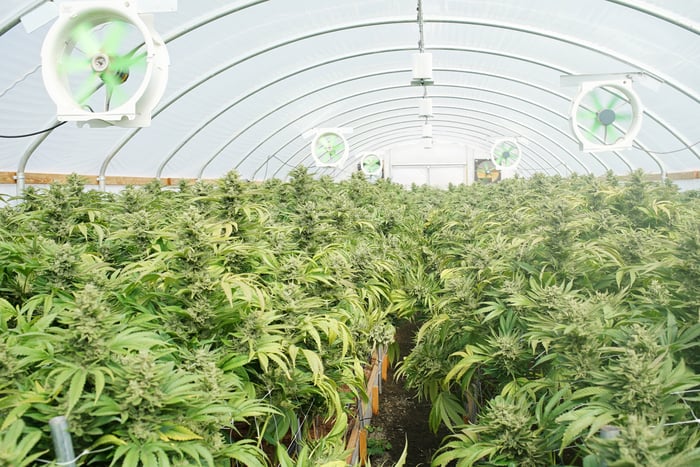The big day is rapidly approaching in Canada. In just 37 days, recreational marijuana will officially be legal for sale to adults aged at least 18 or 19, depending on the province, in licensed dispensaries. And with this legalization comes the potential for the industry to add in the neighborhood of $5 billion in annual sales, once at full capacity, atop what it's been generating from domestic medical cannabis sales and via exports.
Three things to love about Aurora Cannabis
Not surprisingly, marijuana stocks have been off to the races in advance of this Oct. 17 launch. One pot stock in particular that investors can't seem to get enough of is Aurora Cannabis (ACB 13.13%). Sporting a $6 billion market cap, Aurora Cannabis currently slides in as the third-largest publicly traded pot stock, and clearly one of the most active by average trading volume.
What is it about Aurora Cannabis that makes it so special? Let's take a closer look at three things investors probably love about the company.

Image source: Getty Images.
1. Its (expected) industry-leading production
Easily one of the most appealing aspects of Aurora Cannabis is the company's estimated peak production of 570,000 kilograms, when at full capacity. Although Canopy Growth Corp. hasn't divulged a peak production estimate like most pot stocks, there's a decent shot that Aurora Cannabis locks up the top spot as Canada's leading cannabis producer.
Aurora has been exceptionally aggressive with its capacity expansion, catapulting from a little more than 100,000 kilograms in peak annual production at the beginning of the year to about 570,000 kilograms by July. And it's done so organically, via strategic partnership, and by acquisition.
The company's Aurora Sky project was a completely organic build spanning approximately 800,000 square feet, with an expected annual yield of at least 100,000 kilograms, and its ongoing Aurora Sun project in Alberta will span 1.2 million square feet and yield 150,000 kilograms a year when complete. Then there's Aurora's partnership with Alfred Pedersen & Son in Denmark, known as Aurora Nordic, which will produce around 120,000 kilograms per year when fully operational. Lastly, there were the acquisitions of CanniMed Therapeutics and MedReleaf.
Being the top marijuana producer should come with perks, such as strong pricing power, and the desire of provinces and retailers to negotiate in long-term supply deals with Aurora Cannabis.

Image source: Getty Images.
2. The company's high-margin focus and international expansion
Secondly, investors have to be impressed with Aurora Cannabis' unique focus on medical cannabis as recreational legalization looms, as well as its continued push into foreign markets.
With the floodgates about to open, you'd think most growers are readying to focus on adult-use demand -- but that's not in Aurora's game plan. The issue with the recreational market is that dried flower could be easily commoditized, which would wreak havoc on marijuana stock margins, despite economies of scale working in favor of growers. Though we have little precedence to speak of, oversupply has crushed the per-gram price of cannabis in Colorado, Washington, and Oregon, and it's starting to do the same in California. There's a good chance that Canadian growers that focus too heavily on the recreational market could run into similar issues.
By focusing on the medical marijuana market domestically and abroad, Aurora Cannabis is narrowing its pool of prospective consumers but is also securing its pricing power and substantially reducing the possibility of commoditization. It's a smart move to supercharge its longer-term margins.
Aurora will primarily be looking at the roughly 30 countries worldwide that have legalized medical weed in some capacity as its key sources of revenue. Its Aurora Nordic facility in Denmark is expected to be a primary production source for Scandinavia, Denmark, and perhaps other relatively local European countries.

Image source: Getty Images.
3. Its diverse revenue stream
Thirdly, investors have to appreciate the diversity of Aurora Cannabis' revenue stream, which is about much more than just dried cannabis.
As noted, the company will be angling to become a major medical marijuana player globally. As such, it's been working to bolster its product offerings to patients, including oils. In June, Aurora invested 10 million Canadian dollars into Capcium (a 19.99% equity stake) to develop a line of softgel capsules for medical marijuana patients. Though Capcium is working on its own commercial-scale facility, it won't be completed until the fourth quarter of next year. As such, Aurora is allowing Capcium to produce softgel capsules at its Aurora Vie facility in the interim.
Beyond production, Aurora also acquired Larssen in November 2017. Larssen is involved in the design and construction of greenhouses around the globe. Having previously been commissioned for a handful of Aurora's greenhouses, the company decided to gobble up Larssen and internalize its construction and retrofit costs. It also gives Aurora an opportunity to benefit from the expansion and legalization of pot worldwide. Consider this a great means of diversifying its revenue stream even further away from dried cannabis.

Image source: Getty Images.
And the one thing you should hate about Aurora Cannabis
On the other hand, one of investors' favorite marijuana stocks has a very big flaw: dilution.
Prior to the passage of the Cannabis Act, marijuana companies had virtually no access to basic banking services, such as a line of credit, a loan, or even a checking account. Banks feared the possibility of financial and/or criminal penalties if they offered their services to pot-based businesses. This left marijuana stocks like Aurora Cannabis with one solution: turn to bought-deal offerings.
A bought-deal offering involves the sale of common stock, convertible debentures, stock options, and/or warrants in order to raise capital. Truth be told, domestic cannabis sales and exports aren't generating anywhere near enough positive operating cash flow to pay for ongoing capacity expansion projects or acquisitions. As such, companies like Aurora turned to issuing shares like they were going out of style to pay for its transformation.
Since the end of fiscal 2014, Aurora's outstanding share count has ballooned from just over 16 million to around 950 million. With a number of existing convertible notes, stock options, and warrants still outstanding, it's almost assured that Aurora's share count will surpass 1 billion. Aside from weighing down existing shareholders for a long period of time, it also means that Aurora needs to generate CA$100 million just to produce CA$0.10 in earnings per share, which would still represent a nosebleed price-to-earnings ratio of 81.
In other words, Aurora may have clear-cut advantages and things to like, but it's sort of a nightmare from a fundamental and investing perspective.





